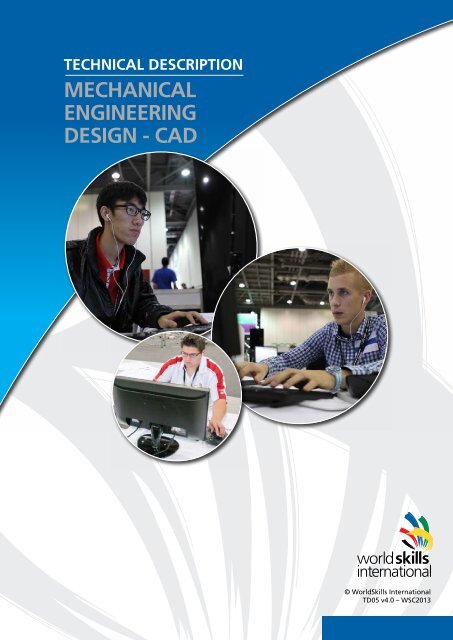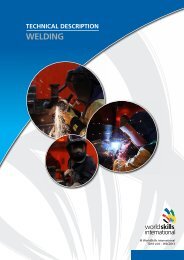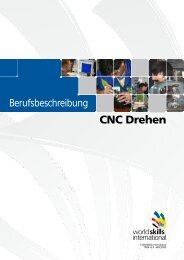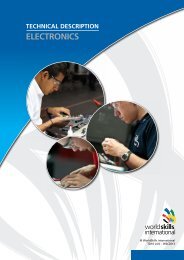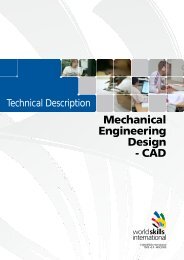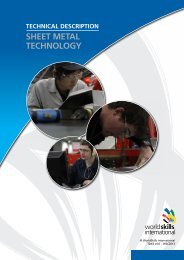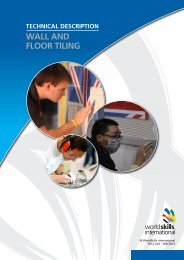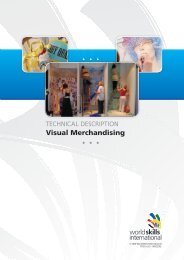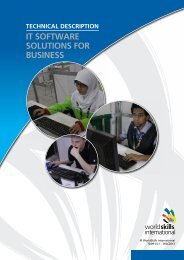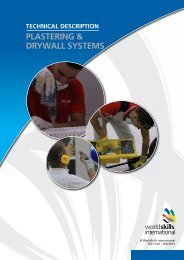mECHANICAL ENgINEERINg DESIgN - CAD
mECHANICAL ENgINEERINg DESIgN - CAD
mECHANICAL ENgINEERINg DESIgN - CAD
You also want an ePaper? Increase the reach of your titles
YUMPU automatically turns print PDFs into web optimized ePapers that Google loves.
TECHNICAL DESCRIPTIONmechanicalengineeringdesign - <strong>CAD</strong>© WorldSkills InternationalTD05 v4.0 – WSC2013
1. INTRODUCTION1.1 Name and description of skill1.1.1 The name of the skill isMechanical Engineering Design – <strong>CAD</strong>1.1.2 Description of skillMechanical Engineering Design covers the use of Computer Aided Design (<strong>CAD</strong>) technology in thepreparation of graphical models, drawings, paperwork and files containing all the informationnecessary for manufacture and documentation of parts and components typical of solutions tomechanical engineering problems facing workers in industry. Solutions will comply with appropriateindustry and ISO standard, latest issue.1.2 Scope of application1.2.1 Every Expert and Competitor must know this Technical Description.1.2.2 In the event of any conflict within the different languages of the Technical Descriptions, the Englishversion takes precedence.1.3 Associated documents1.3.1 As this Technical Description contains only skill-specific information it must be used in associationwith the following: WSI - Competition Rules WSI - Online resources as indicated in this document Host Country - Health and Safety regulations2. COMPETENCY AND SCOPE OF WORKThe Competition is a demonstration and assessment of the competencies associated with this skill.The Test Project consists of practical work only.2.1 Competency specificationThe following competencies will be tested within one or more of the individual modules listed below3D modelling of partKnowledge and understanding of 3D modelling of part: Have sufficient knowledge of Autodesk Inventor to be able configure the parameters of thesoftware Have sufficient knowledge of computer operating systems to be able to use and managecomputer files and software correctlyThe competitor shall be able to: Perform the modelling of the components, optimizing the constructive solid geometry. Create families of components (a maximum of 3 variables) Ascribe characteristics to the materials (density) Ascribe colours and textures to the componentsWSC2013_TD05_ENDate: 11.10.11 – v4.0Copyright © WorldSkills International. All rights reserved.Mechanical Engineering Design - <strong>CAD</strong> 2 of 15
3D modelling of assembliesKnowledge and understanding of 3D modelling of assemblies: Understand mechanical systems and their functionalityThe competitor shall be able to: Produce an assembly from 3D models of components. Structure an assembly (sub-assemblies)Create photo rendered imagesKnowledge and understanding of rendering: Understand the use of lighting, scenes and decals to produce photo rendered imagesThe competitor shall be able to: Create photo rendered images of components or assembliesCreation of simulationsKnowledge and understanding of creating simulations: Understand mechanical systems and their functionalityThe competitor shall be able to: Create functional simulations relative to the operation of the system being designed usingAutodesk Inventor Studio.Reverse engineering of a physical modelKnowledge and understanding of reverse engineering of a physical model: Knowledge of materials and processes for obtaining unprocessed workpieces (casting, welding,machining, simulation, etc)The competitor shall be able to: Determine dimensions on a physical part by means of the instruments described underparagraph 3.2 Test Project design requirements Creating freehand sketchesTechnical drawings and dimensioningKnowledge and understanding of technical drawings and dimensioning: Understand working drawings in ISO standards together with any written instruction. Knowledge of standards for conventional dimensioning and tolerancing, and geometricdimensioning and tolerancing appropriate to the ISO standards. Thorough understanding of the rules of technical drawing and the prevailing latest ISOstandards that govern those rules Using the manuals, tables, lists of standards and product catalogues Using plotters and printersThe competitor shall be able to: Interpret and execute drawings and diagrams Create freehand sketches Produce print outs of drawings in sizes A0 to A4MaterialsKnowledge and understanding of materials: Knowledge of materials and processes for obtaining unprocessed workpieces (casting, welding,machining, simulation, etc)WSC2013_TD05_ENDate: 11.10.11 – v4.0Copyright © WorldSkills International. All rights reserved.Mechanical Engineering Design - <strong>CAD</strong> 3 of 15
Software and hardwareKnowledge and understanding of software and hardware: Understanding of how to configure the parameters of the software Knowledge of computer operating systems to be able to use and manage computer files andsoftware correctly Working knowledge to use plotters and printers2.2 Theoretical knowledge2.2.1 Theoretical knowledge is required but not tested explicitly.2.2.2 Knowledge of rules and regulations is not examined.2.3 Practical workPractical tasks will be given in the form of sketches, drawings and electronic data files, individualphysical components and assemblies. Collection of information from these sources will requirereading of prints, sketches, drawings, engineering tables, charts, and manuals. Additionalinformation will be obtained from direct measurement of actual parts supplied and/or from scaleddrawings. Problems will require solutions in the form of graphical and textual descriptions, sufficientto communicate successfully the information necessary for manufacturing of these componentsand assemblies in industry.Only the English version of the chosen software is to be used during the Competition.3. THE TEST PROJECT3.1 Format / structure of the Test ProjectThe Test Project is a series of 4 standalone modules.Skills that could be tested in the different modules could cover: Sheet Metal parts and Frame structures and assemblies Welded parts and assemblies Mechanical parts and assemblies Detail drawing Functional Simulation and photo rendering Reverse engineering from a physical model Modification of a product to fulfil and design brief.A combination of the above skills is allowed in each module.WSC2013_TD05_ENDate: 11.10.11 – v4.0Copyright © WorldSkills International. All rights reserved.Mechanical Engineering Design - <strong>CAD</strong> 4 of 15
3.2 Test Project design requirementsThe Competition is divided into 4 modules covering the following categories:Day 1 (6 hours) – Mechanical assemblies and detail drawing for manufacture:Data: Finished drawings of components or assemblies 3D models of components or assemblies Nomenclature All necessary additional informationWork requested: To produce models of components from detail drawings To produce an assembly To produce detail drawing(s) for manufacture To input components from Inventor Content CentreResults expected: Part and Assembly file(s) Assembly drawing(s) Detail drawings for manufacture Nomenclature Exploded view(s)Day 2 (6 hours) – Mechanical Fabrication:Data: Finished drawings of components 3D models of components or assemblies Nomenclature All necessary additional informationWork requested: To produce sheet metal parts and assemblies To produce metal frame parts and assemblies using Autodesk Inventor Frame Generator To add welded connections to parts and assemblies To add bolted connections to parts and assemblies To produce sheet metal and welding detail drawingsResults expected: Part and Assembly file(s) Assembly drawing(s) Detail drawings for manufacture NomenclatureDay 3 (6 hours) – Mechanical Design Challenge:Data: Assemblies (3D models) Layout (assemblies and components) Technical specifications for the design change to be applied Design brief All necessary additional informationWSC2013_TD05_ENDate: 11.10.11 – v4.0Copyright © WorldSkills International. All rights reserved.Mechanical Engineering Design - <strong>CAD</strong> 5 of 15
Work requested: Produce functional assembly(s) from given data Implement the design change Autodesk Inventor Design Accelerator may be used to generate parts and assemblies Produce assembly drawing(s) of design change Produce exploded views Produce physical simulations using Autodesk Inventor Studio Produce photo rendered images using Autodesk Inventor StudioResults expected: Modified files (components and assemblies) Assembly drawing of design change Animation showing full exploded view sequence of design change in file format .avi Animation showing full physical simulation of design change in file format .avi Photo Rendered images of design change up to a maximum of A3 size NomenclatureDay 4 (4 hours) – Reverse Engineering from a Physical Model:Data: Physical component(s) and assembly(ies) File of parts and assemblies All the necessary additional informationWork requested: Making files and layout from dimensions taken from a physical component The scaled drawing will be produced using measuring instruments in Annex 1 Tool List The use of systems enabling the memorization of scaled drawings or shapes is prohibited(Photographs, malleable putty, ink pad, etc) The Competitor may produce sketches on paper which will serve as the basis for producing the3D modelling of the components or assemblies. The physical component(s) will be given to the Competitors for 2 hours and then confiscated.The Competitor will then continue his task on the basis of the sketches and informationcollected previously. The use of the computer is allowed during all the competition time.Results expected: 3D models of components or assemblies Manufacturing drawing(s) of components or assembliesOutput formatUse of Autodesk Inventor Professional. The version will be determined by the Chief Expert 6months before the Competition. Drawing plotted on sizes A1 and smaller Charts, table and documents printed by laser printers on paper sizes A3. Screenshots, rendering on colour printer to a maximum size of A3 Files, components, assemblies, etc according to the instructions for the test During the competition, each competitor is allowed no more than 2 checking prints of eachdrawing. The final printing will take place at the end of each competition day.. PDF prints may be asked to reduce the paper waste3.3 Test Project developmentThe Test Project MUST be submitted using the templates provided by WorldSkills International(http://www.worldskills.org/competitionpreparation). Use the Word template for text documents andDWG template for drawings.WSC2013_TD05_ENDate: 11.10.11 – v4.0Copyright © WorldSkills International. All rights reserved.Mechanical Engineering Design - <strong>CAD</strong> 6 of 15
3.3.1 Who develops the Test Project / modulesThe Test Project / modules are developed by:An External Enterprise (Autodesk)3.3.2 How and where is the Test Project / modules developedThe external enterprise is to produce 6 Test Projects (Modules), 4 to use in the Competition and 2more as a backup plan.The external enterprise is to produce 1 extra Test Project, 3 months before Competition, to bepublished to all experts. Like this we can check the quality of the project and still have time topropose changes to the format. This project won’t be used in the Competition.The Test Project must be developed in Autodesk Inventor, and all files must come along with theTest Project.All the physical models to Module 4 (one for each Competitor), must be provided by the ExternalEnterprise to WS International, one month before Competition.The presence of a Technical/Support Team from Autodesk, during all pre-competition andCompetition period (if possible the presence of the TP designer).3.3.3 When is the Test Project developedThe Test Project is developed:By 3 months before the current Competition.One month before the Competition the Test Project must be submitted to WorldSkills for validation3.4 Test Project marking schemeEach Test Project must be accompanied by a marking scheme proposal based on the assessmentcriteria defined in Section 5.3.4.1 The marking scheme proposal is developed by the person(s) developing the Test Project. Thedetailed and final marking scheme is developed and agreed by all Experts at the Competition.3.4.2 Marking schemes should be entered into the CIS prior to the Competition.3.5 Test Project validationAt the Competition all Experts will be divided into 4 groups. Each group will be given the task toverify the validity of one the finally selected Test Projects. The group will be required to: Verify that all documents are present Verify that Test Project is within the design criteria Ensure that the Test Project can be completed within the time frame Ensure that proposed marking aspects are adequate If, after examination, the selected Test Project is found incomplete or unfeasible, it shall bediscarded and replaced with the backup Test Project.3.6 Test Project selectionThe Test Project is selected as follows:Not applicable.WSC2013_TD05_ENDate: 11.10.11 – v4.0Copyright © WorldSkills International. All rights reserved.Mechanical Engineering Design - <strong>CAD</strong> 7 of 15
3.7 Test Project circulationThe Test Project is circulated via WorldSkills International website as follows:Not circulated.3.8 Test Project coordination (preparation for Competition)Coordination of the Test Project will be undertaken by:The Chief Expert and the Technical Director.3.9 Test Project change at the CompetitionNot applicable.3.10 Material or manufacturer specificationsNot applicable.4. SKILL MANAGEMENT AND COMMUNICATION4.1 Discussion ForumPrior to the Competition, all discussion, communication, collaboration and decision makingregarding the skill must take place on the skill-specific Discussion Forum(http://www.worldskills.org/forums). All skill-related decisions and communication are only valid ifthey take place on the forum. The Chief Expert (or an Expert nominated by the Chief Expert) will bemoderator for this forum. Refer to Competition Rules for the timeline of communication andcompetition development requirements.4.2 Competitor informationAll information for registered Competitors is available from the Competitor Centre(http://www.worldskills.org/competitorcentre).This information includes: Competition Rules Technical Descriptions Test Projects Other Competition-related information4.3 Test ProjectsCirculated Test Projects will be available from worldskills.org(http://www.worldskills.org/testprojects) and the Competitor Centre(http://www.worldskills.org/competitorcentre).4.4 Day-to-day managementThe day-to-day management is defined in the Skill Management Plan that is created by the SkillManagement Team led by the Chief Expert. The Skill Management Team comprises the JuryPresident, Chief Expert and Deputy Chief Expert. The Skill Management Plan is progressivelydeveloped in the six months prior to the Competition and finalised at the Competition by agreementof the Experts. The Skill Management Plan can be viewed in the Expert Centre(http://www.worldskills.org/expertcentre).WSC2013_TD05_ENDate: 11.10.11 – v4.0Copyright © WorldSkills International. All rights reserved.Mechanical Engineering Design - <strong>CAD</strong> 8 of 15
5. ASSESSMENTThis section describes how the Experts will assess the Test Project / modules. It also specifies theassessment specifications and procedures and requirements for marking.5.1 Assessment criteriaThis section defines the assessment criteria and the number of marks (subjective and objective)awarded. The total number of marks for all assessment criteria must be 100.5.2 Subjective markingSection Criterion MarksSubjective(if applicable)Objective TotalA Module 1 – Mechanical1 24 25Assemblies & DetailDrawing for ManufactureNameB Module 2 – Mechanical1 24 25Fabrication NameC Module 3 – Mechanical5 20 25Design ChallengeD Module 4 – ReverseEngineering from aPhysical Model Name1 24 25Scores are awarded on a scale of 1 to 10.5.3 Skill assessment specificationTotal = 8 92 100Module 1 - Mechanical Assemblies & Detail Drawing for Manufacture Part Modelling Assembly Modelling Dimensioning inc GDT Drawing Views & Presentation (part subjective)Module 2 – Mechanical Fabrication Sheet Metal Parts and Assemblies Frame Parts and Assemblies Fabrication Drawing Details Drawing Views & Presentation (part subjective)Module 3 – Mechanical Design Challenge Fulfilment of the Design Brief (part subjective) Physical Simulation (part subjective) Exploded view (simulation) (part subjective) Photo Rendering (part subjective)Module 4 – Reverse Engineering from a Physical Model Presence of part features Accuracy of dimensions Tolerances Surfaces Presentation (subjective)WSC2013_TD05_ENDate: 11.10.11 – v4.0Copyright © WorldSkills International. All rights reserved.Mechanical Engineering Design - <strong>CAD</strong> 9 of 15
5.4 Skill assessment proceduresThe Chief Expert will divide the Experts into 4 groups. They will make sure to have Experts withWorldSkills experience and first Competition Experts in the same group.Each group will be responsible to mark every aspect in one of the four Test Project modules.Each Expert will mark all the aspects in the day that their group is responsible.Each Expert will mark exactly 25% of the total marks assessed.At the end of each day the marks will be entered into the CIS.Blind marking will be applied whenever possible.There are no special processes to be followed during marking.6. SKILL-SPECIFIC SAFETY REQUIREMENTSRefer to Host Country Health & Safety documentation for Host Country regulations.None7. MATERIALS & EQUIPMENT7.1 Infrastructure ListThe Infrastructure List details all equipment, materials and facilities provided by the Host Country.The Infrastructure List is online (http://www.worldskills.org/infrastructure/).The Infrastructure List specifies the items & quantities requested by the Experts for the nextCompetition. The Competition Organiser will progressively update the Infrastructure List specifyingthe actual quantity, type, brand/model of the items. Items supplied by the Competition Organiserare shown in a separate column.At each Competition, the Experts must review and update the Infrastructure List in preparation forthe next Competition. Experts must advise the Technical Director of any increases in space and/orequipment.At each Competition, the Technical Observer must audit the Infrastructure List that was used atthat Competition.The Infrastructure List does not include items that Competitors and/or Experts are required to bringand items that Competitors are not allowed to bring – they are specified below.WSC2013_TD05_ENDate: 11.10.11 – v4.0Copyright © WorldSkills International. All rights reserved.Mechanical Engineering Design - <strong>CAD</strong> 10 of 15
7.2 Materials, equipment and tools supplied by Competitors in their toolbox Compendium of standards Technical manuals Instruments for freehand sketching Measuring instruments (Appendix 1 Tool List). The Competition Organiser must supply identical tools during the Competition for allCompetitors. Personal keyboard and mouse (including drivers), if different than the ones supplied by HostMember “Space Mouse” (3D Mouse) will be permitted if the brand is approved by the Experts on theDiscussion Forum if different from the one provided in the Infrastructure List.7.3 Materials, equipment and tools supplied by ExpertsNot applicable7.4 Materials & equipment prohibited in the skill areaAll materials and equipment brought by Competitors will have to be presented to the Experts. TheJury shall rule out any items brought to the Competition that are not considered normal EngineeringDrawing and <strong>CAD</strong> related tools and equipment, that will give any Competitor an unfair advantage.7.5 Proposed workshop and workstation layoutsWorkshop layouts from London are available at:http://www.worldskills.org/index.php?option=com_halls&Itemid=540Workshop layout:WSC2013_TD05_ENDate: 11.10.11 – v4.0Copyright © WorldSkills International. All rights reserved.Mechanical Engineering Design - <strong>CAD</strong> 11 of 15
8. MARKETING THE SKILL TO VISITORS AND MEDIA8.1 Maximising visitor and media engagementBelow is a list of possible ways to maximise visitor and media engagement for this skill: Try a trade Display screens Test Project descriptions Enhanced understanding of Competitor activity Competitor profiles Career opportunities Daily reporting of competition status8.2 Sustainability Recycling Use of ‘green’ materials Use of completed Test Projects after CompetitionWSC2013_TD05_ENDate: 11.10.11 – v4.0Copyright © WorldSkills International. All rights reserved.Mechanical Engineering Design - <strong>CAD</strong> 12 of 15
9. APPENDICES9.1 Appendix 1 – Tool listDigital Caliper (0-150mm or 0-200mm)Offset Centerline CaliperDigital or Universal ProtractorWSC2013_TD05_ENDate: 11.10.11 – v4.0Copyright © WorldSkills International. All rights reserved.Mechanical Engineering Design - <strong>CAD</strong> 13 of 15
Radius Gages (0,4 to 25mm)External Metric Thread Pitch Gage (0.35 to 6mm)Internal Metric Thread Pitch Gage (0.35 to 6mm)Use of screws/thread plugs is allowedSurface comparator gauges (Ra)WSC2013_TD05_ENDate: 11.10.11 – v4.0Copyright © WorldSkills International. All rights reserved.Mechanical Engineering Design - <strong>CAD</strong> 14 of 15
Metalic Ruler (0-300mm)WSC2013_TD05_ENDate: 11.10.11 – v4.0Copyright © WorldSkills International. All rights reserved.Mechanical Engineering Design - <strong>CAD</strong> 15 of 15


